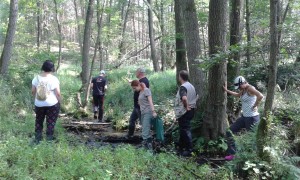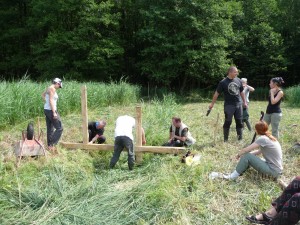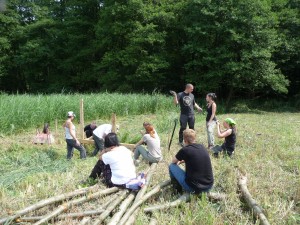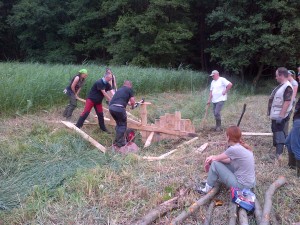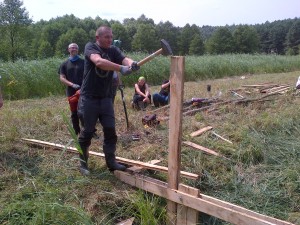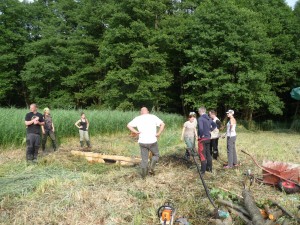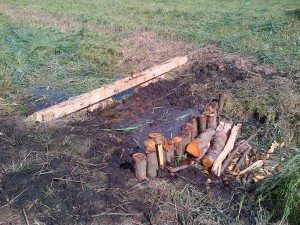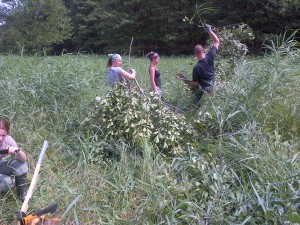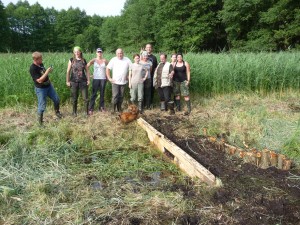Workshop on practical protection of fens
On 21st – 22nd July Klub Przyrodników organized a workshop practical protection of fens. Practical methods for protecting fens have been demonstrated on one of the 86 areas – Kosobudki. The area was purchased by the Klub last year.
Kosobudki belongs to one of the best preserved fens in the Natura 2000 site “Dolina Pliszki” PLH080011, where approx. 70% of the surface is covered with characteristic fen vegetation. Among the characteristic alkaline fens brown mosses one can find here species such Helodium blandowii, Tomentypnum nitens and occurring here Paludella squarrosa, which was discovered only this year (within monitoring conducted within the project). The rest of the area are covered by rushes of sedge and cane, patches of occurring along the river Pliszka alder. The objects also confirmed the presence of rare species of fauna, ie. Vertigo moulisiana and angustior.
The workshop started in a relaxed atmosphere, with coffee and home-made cakes, while participants were acquainted with the presentation on the general characteristics of wetland ecosystems. Participants, who were for the first time in workshops / meetings of the Klub, were acquainted also with the aims and objectives of the Project. Then we went directly on the Kosobudki, where the participants were familiar with the frequent here spring-fed fen, their geological structure, occurring species of characteristic fen vegetation and specificity of existing water conditions.
The greatest threat to most alkaline fens in Poland, where Kosobudki is not the exception, is adverse effects of water scarcity, caused by a dense network of drainage ditches contributing to the degradation of fen and vegetation succession in the direction of forest or scrub (usually as a consequence of adverse changes in water conditions inducing desiccation).
The workshop aimed at presenting ways to protect fens and how to minimize the risks described above. We set up one construction biuld with wood and soil at the deepest drainage ditch and we deforested near 1ha of alder raids, to restore the open character of the fen. Due to the high efficiency of the workshop participants we manage to made on the second day of the workshop an additional construction – that is 200% of the norm 🙂 !
The construction of dam, although very simple, effectively inhibit excessive outflow of water from the fen. It is made of two walls – the front one made from oak wood boards with a thickness of approx. 4 cm, and width of approx. 12-20 cm, and different lengths. Back wall – a palisade – was made of cut piles of alder, and the space between the walls of approx. 1 m filled the native soil (peat). So constructed dam guarantees halting the excessive outflow of water from the fen. All work was done by hand, thereby reducing interference with the habitat to a minimum.
And was the effect? See by yourself on the photos below! Within a few hours after finishing the earthworks, the constructions dammed up water up to the presumed level!
Thank you all the workshop participants for your hard work in unfavorable conditions (temperature was 33 Celsius degree!) acompanied with a flock of mosquitoes and horseflies, and for very nice evening around the campfire. We hope that yet again we will meet together at a common work!
Participants listen to the lecture on the characteristics of spring-fed fens.
The begining of the construction works.
At the end of first day of the workshops. One can see the construction with overflow and water that already begun to accumulate in the ditch.
Final effect of the first day of the workshop.
Removing by hand trees and shrubs of alder.
Biomass was removed from the fen and stored in alder woods along the Pliszka river to enrich the dead wood base.
Well deserved rest after the second day of the workshops.
Almost 🙂 all workshop participants
We invite you to watch also some short videos documenting our work – videos was made by and shared by Łukasz Krajewski – one of the workshop participant.
https://www.youtube.com/watch?v=If4k7Pz3OZg&feature=youtu.be
This text is also available in: PL

